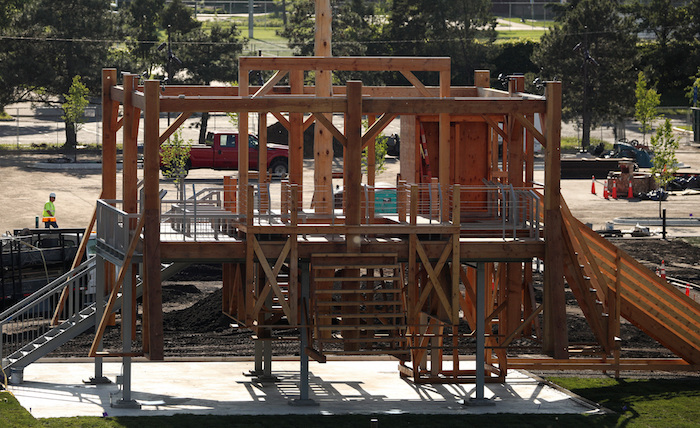Is Truth the First Casualty of Art?
The Walker Art Center has been in the news lately. The Walker has completely redone its sculpture garden, long a favorite haunt of families with children. But the garden’s re-opening has been derailed by controversy over a sculpture called “Scaffold,” created by California artist Sam Durant. The Star Tribune writes that the sculpture looks like a “wooden jungle gym,” but Durant explains that “Scaffold” is meant to evoke various hangings from America’s past:
[T]he design is actually a composite of the gallows used in seven U.S. government-sanctioned executions, from the 1859 hanging of abolitionist John Brown to the 2006 execution of former Iraqi President Saddam Hussein.
One of the seven executions represented by “Scaffold” is the hanging of 38 Sioux or Dakota men following the uprising of 1862. There aren’t many descendants of John Brown in Minnesota, or Iraqi-Americans who sympathize with Saddam Hussein, but there are quite a few Dakotas. A number of them objected to “Scaffold” on the ground that it is insensitive and represents “cultural appropriation.” A group of Indians picketed and demonstrated at the sculpture garden, not the sort of publicity the Walker Art Center welcomes. Predictably, the Walker gave in and announced that it will dismantle “Scaffold.”
Along the way, a great deal of misinformation has been spread, as is always the case when the 1862 Dakota war makes news. The Star Tribune’s articles contain careless references to “genocide,” “lynching,” and so on. The Walker has apologized profusely, and predictably, money will flow to purported “leaders” of Minnesota’s Dakota Indians.
Lost in the shuffle is the true story of what happened in 1862. All participants in the current controversy take it as given that the hanging of 38 Sioux warriors was, somehow, an outrage. The truth is far different. I wrote about what really happened on another web site. It is worth remembering:
The Dakota uprising of 1862 is one of the major events in Minnesota’s history. It began with a series of spree killings by young Dakotas and grew into a slaughter that extended up and down the Minnesota River. Hundreds of white men, women and children were massacred by the Dakota, who descended on their homes without warning and slaughtered the whites without mercy. Minnesotans organized a militia to resist the Indian attacks, and President Lincoln sent a detachment of Union soldiers who finally assisted in putting down the rebellion.
At the end of the war, Union soldiers held over 1,000 Dakota prisoners. The military held a series of trials which resulted in the convictions of 303 Dakota warriors, who were sentenced to hang. All of this occurred during the worst days of the Civil War, when it appeared that the Union likely would be dissolved. Nonetheless, Lincoln was concerned about whether justice had been done to the Dakotas. He obtained copies of the trial transcripts and, in the middle of the night–his days being fully occupied with the war–he studied them. Lincoln’s standard was that he would only allow the hanging of men against whom there was convincing evidence of either murder or rape. Killing in battle didn’t count.
Based on his review, Lincoln commuted the sentences of all but 38 of the Indians. He directed that the rest be set free. General John Pope, commander of the Union troops in Minnesota, protested that if he released the remaining Indians, settlers would kill them. Lincoln replied that Pope must do his duty and protect the Indians.
On December 26, 1862, the 38 convicted murderers and rapists were hanged in Mankato, Minnesota, the largest such execution in American history. Every year at around this time, the war of 1862 and the hangings at Mankato are revisited in our local media. Rarely is the story told honestly. Today, the Indians who were convicted of rape or murder, and whose convictions were upheld on review by Abraham Lincoln, are generally regarded as heroes, while their execution is portrayed as a moment of infamy.
Scott [Johnson] and I wrote an article about this episode in the Minneapolis Star Tribune in 1998, and I wrote about it on Power Line four years later. I think we have revisited the topic once or twice since. Despite our efforts to bring balance to the historical record, the revisionist narrative marches on. Every year, there is a commemorative ride from Crow Creek, South Dakota to Mankato to honor those who were hanged. The Star Tribune covered the ride yesterday:
On December 26, 1862, on orders signed by President Lincoln, 38 Dakota fighters were hanged in Mankato following the bloody, six-week U.S.-Dakota War.
They weren’t hanged for being “fighters,” they were hanged for being murderers and/or rapists. Left unmentioned is that the Dakotas had already been condemned to hang. The effect of Lincoln’s order was to exonerate more than 250 Dakotas who, but for his review, would have been executed.
There is more at the link, including a recent battle over the depiction of the Dakotas’ attack on New Ulm in a painting that hangs at the Minnesota Capitol. I concluded that “the Left’s dogged effort to portray the 1862 hanging of murderers and rapists as a shameful, racist episode continues.” That effort continues today, and hardly anyone seems motivated to set the record straight. The hundreds of whites who were slaughtered have been forgotten.
A footnote: the Minnesota Historical Society has copies of the transcripts of the trials of the Dakotas at the end of the war, the same ones that President Lincoln reviewed. You can see them at the Minnesota History Center in St. Paul. Scott Johnson and I read them all, some years ago. I think we can say with confidence that no one involved in the present controversy–reporters, artists, activists–has taken the trouble to do the same, and to learn what really happened in 1862.
